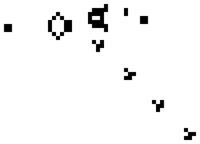Conway's Game of Life

The Game of Life is a computer game created by British mathematician John Horton Conway in the 1970s. It is a game that is played on a grid, like a checkerboard, with each square representing a space where something can happen. You start the game by placing a few pieces, called 'cells', onto the grid. Each cell can be either 'alive' or 'dead'. Then, you watch as the game unfolds.
Each turn in the game of life follows some simple rules. If a dead cell has exactly three living neighbors, it comes to life. If a living cell has two or three living neighbors, it stays alive; if it has fewer than two it dies, and if it has more than three, it dies. Each turn, these rules are applied to every cell on the grid, and the end result changes the pattern on the grid.
Many different patterns can develop in the game of life, some of which look like shapes you would recognize, like guns and gliders. People all over the world have enjoyed creating interesting patterns and watching the way they change.
Whenever you play the game, the patterns you see depend on the starting configuration of cells and the rules you use. Playing the game of life can be fun, thought-provoking, and endlessly fascinating.
Each turn in the game of life follows some simple rules. If a dead cell has exactly three living neighbors, it comes to life. If a living cell has two or three living neighbors, it stays alive; if it has fewer than two it dies, and if it has more than three, it dies. Each turn, these rules are applied to every cell on the grid, and the end result changes the pattern on the grid.
Many different patterns can develop in the game of life, some of which look like shapes you would recognize, like guns and gliders. People all over the world have enjoyed creating interesting patterns and watching the way they change.
Whenever you play the game, the patterns you see depend on the starting configuration of cells and the rules you use. Playing the game of life can be fun, thought-provoking, and endlessly fascinating.
Related topics others have asked about:
